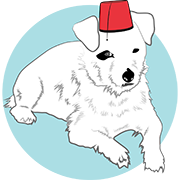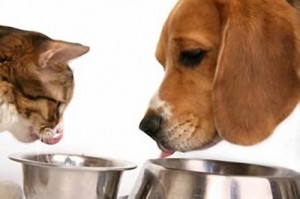The pendulum has swung. From taking a laissez-faire attitude towards pet food, we dog and cat owners have become increasingly focused on the contents of our companion animals’ bowls. And what with the resultant glut of information, it’s not easy to separate the wheat from the chaff — or decide whether our pets should even be eating wheat.
This week’s guest on Animal Cafe, Marcy Campion, PhD., a dog and cat nutritionist who currently serves as the Scientific Relations Managers for Iams/P&G Pet Care, discusses some of these issues with veterinary expert Dr. Lorie Huston.
This interview focuses on Iams’ new Healthy Naturals food lines, and as Lorie points out, not everyone will agree with all the assessments given — I’m not convinced, for example, of the effectiveness of AAFCO (the Association of American Feed Control Officials) — but I think it’s interesting that a mainstream company like Iams has gotten on the natural bandwagon to begin with.
Here are a few general principles that can be applied to whatever food you choose to buy.
Great grains!
An extension of the trend towards wanting to know where own food is coming from, we want our pet food to be equally healthy and well-sourced.
But several myths have crept into the conversation, including the notion that all grains are evil. As someone who includes brown rice in Frankie’s diet, I take exception to that notion — as does Campion.
“Grains in general are good sources of carbohydrates,” she points out. “They often add fiber.” There is nothing inherently wrong with them.
Campion notes that some people believe that corn in particular causes allergies in pets, but refutes that notion. “Along with beef and dairy, wheat is one of the things that causes the most allergies,”she says. “Corn is very far down on the list, and wouldn’t commonly cause a food allergy in dogs.”
In addition, grains tend to be dismissed as filler, or food that has no nutritional value. But grains are often an energy source, according to Campion, and help promote healthy activity levels.
Cats and Carbs
Campion says that, “A lot of people think of cats as small dogs,” and assume that the two species have similar nutritional needs. Not so. Cats have evolved as carnivores, while dogs are omnivores.
But while cats should not be made into vegetarians, that doesn’t mean they can’t utilize carbohydrates, she says. Campion recommends that meat be the primary protein source, but finds no problem including fruits and vegetables in feline pet food formulas, as they provide antioxidants.
Not all by-products are created equal
While I don’t agree that it’s just a rumor that disgusting — as in diseased — by-products go into a good deal of pet food, at the same time, it’s clear that not all meat by-products that humans won’t eat are unhealthy for pets. Internal organs can be a great source of natural amino acids, Campion says, and cats and dogs eat them in the wild.
***
To learn more about pet food ingredients and about the new Iams line, which will be available at grocers and mass retailers, as well as at PetSmart, listen to the interview here.


I feed my dog both kibble and canned food. The canned food that is my favorite is Tiki Dog. I can recognize all the ingredients by sight and name. Their website says all meat and veggies are human consumption grade. It doesn’t even smell like dog food. It has brown rice in it.
This is a very useful post! I admire the people who put lots of time and thought and care into preparing raw/organic/homemade meals for their pets, and I think it certainly can’t hurt and is probably really good for dogs. Personally, I just don’t think I’ll ever be able to commit to putting that much time into food preparation for my dogs or myself–so I try to make sure that we all have diverse diets with foods that we enjoy, and leave it at that!
That seems fair and it’s pretty much my diet philosophy too though I do prepare Frankie’s food — on and off — in (shhhh!) a microwave.
Hi Edie
I cook fresh chicken daily for Dougie in the microwave and he’s had that diet with no canned food since born. Dougie likes his chicken slightly warm, so I serve after cooling for say 10 mins when chopped up. Dougs won’t eat canned food but now has some senior crunchy biscuits with vitamins. Rice, can’t get him to eat it, he manages to sift it from chicken expertly!!
Ha, you cater to Dougie as much as I do to Frankie! I love the vision of him sifting the rice away. Frankie is able to do that with kibble that he doesn’t like — he doesn’t get it anymore — but sifting rice from chicken is a very special talent!
You go spend a fortune on organic human-grade dog food… and then they drink out of mud puddles and the toilet bowl.
Right now Our Best Friend is on diet kibble because he got FAT and I know I don’t have what it takes to give a dog insulin…
Ah but Lori, those puddles are organic…
As for the diet — that’s always a good thing, but obesity has no connection with diabetes in dogs; Frankie was svelte when he was diagnosed. It’s heredity. (But you do have what it takes to give Your Best Friend insulin, I’m certain.)
Funny, my vet warned me that if Our Best Friend didn’t lose some weight, he was at risk for diabetes. Is it possible that they have Type 1 and Type 2, like humans? I really know nothing about it.
Nope, the only other variety in dogs is related to female hormones, as I footnoted. Trust me — I’ve done a lot of research, including two articles for Your Dog, the Tufts University veterinary school on the topic of canine diabetes; I just finished the second one. I asked the veterinary expert several times, just to make sure, that I hadn’t gotten it wrong. There’s no correlation between obesity and canine diabetes, though there is one for obesity and feline diabetes.
I believe you, honest! Now I’ll worry less about his weight, though I’m sure losing those extra five pounds are still in his best interest, even if not to prevent diabetes. Thanks, Ms Jarolim!
You’re welcome — but why so formal, Lori? That authoritative tone, huh?
Puddles are why I finally gave in and give my dog tap water at home instead of filtered or bottle water. But on the road, she has to settle for bottled water. Since I started giving her tap water, she usually doesn’t try to get the puddles anymore. I don’t like her to try the puddles, never know what icky stuff from the road is in them.
I am incredibly picky about my dogs food. If you can buy it in a supermarket, the dogs don’t get it. I feed Honest Kitchen Preference dehydrated veggie mix and add my own cooked meat, usually chicken hearts, livers, gizzards etc. The kibble brands vary by what pet food store I’m in, but I usually feed Before Grain that use carb sources like sweet potatoe.
A good rule to follow when buying kibble is that of the first three ingredients on the bag, two of them should be protein based. The protein sources should be specified ie. chicken, salmon, lamb and NOT be a “by-product”. That way you know you are getting a quality meat source.
Well, there are veterinarians who object to some of those facts/beliefs. For myself I am happy that I am the one who selects what exactly goes into my dog’s bowl.
Interesting post, Edie! I will freely admit to being a member of the grain-free camp. After feeding our Felix a low level grain food, then a high-quality grain food and eventually a grain free food, I saw a significant increase in overall health on the low carb, grain free diet. I actually wrote a whole blog series on why I went that route. I’m not actually opposed to the grains themselves, in fact, I often use them in my home cooked meals and treats. It’s the notion that some dogs foods (even the premium ones) are more than half grain or that some of the lower quality brands are even almost ALL grain that gets under my skin. Take, for example, the Healthy Naturals – of the first six ingredients, four are grains. Since grain is weighed dry, while meat and meat meal are weighed including the water content, which is later cooked off to create a dry kibble, this food has way more grain than meat in it. If there was a kibble on the market that had grain in a reasonable quantity, I don’t think I’ object to it at all. Sadly, I just haven’t found that kibble.
Good points, Jodi, and thanks for your analysis of the Healthy Naturals content. There probably is a kibble that meets your criteria — I’d bet if you put the call out there on your blog you will get suggestions, possibly even free manufacturer samples 😉